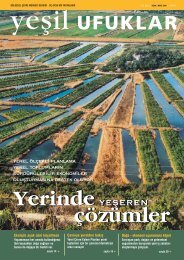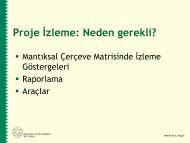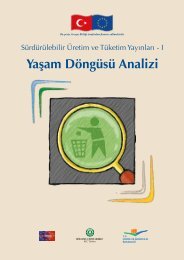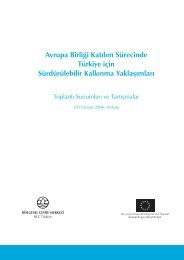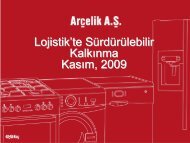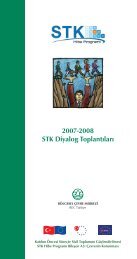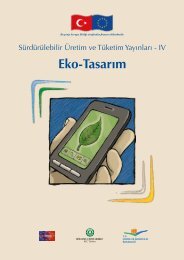Directive 2001/18/EC
Directive 2001/18/EC
Directive 2001/18/EC
Create successful ePaper yourself
Turn your PDF publications into a flip-book with our unique Google optimized e-Paper software.
EU regulatory framework on GMOs<br />
Yannis Karamitsios<br />
DG Health and Consumers – Unit E.1<br />
yannis.karamitsios@ec.europa.eu<br />
tel: : 0032 2 29 83 089
Overview<br />
‣ <strong>Directive</strong> <strong>2001</strong>/<strong>18</strong>/<strong>EC</strong> on the deliberate release into the<br />
environment of genetically modified organisms<br />
‣ Regulation(<strong>EC</strong>) ) No <strong>18</strong>29/2003 on GM food and feed<br />
‣ <strong>Directive</strong> 2009/41/<strong>EC</strong> on the contained use of genetically<br />
modified micro-organisms<br />
organisms<br />
‣ Regulation <strong>18</strong>30/2003 on the traceability and labelling of<br />
GMOs and GM food and feed products<br />
‣ Regulation 1946/2003 on the implementation of the<br />
Cartagena Protocol
<strong>Directive</strong> <strong>2001</strong>/<strong>18</strong>/<strong>EC</strong> on the<br />
deliberate release into the<br />
environment of genetically modified<br />
organisms and repealing Council<br />
<strong>Directive</strong> 90/220/E<strong>EC</strong>
<strong>Directive</strong> <strong>2001</strong>/<strong>18</strong>/<strong>EC</strong><br />
Structure<br />
‣ PART A: General provisions<br />
‣ PART B: Release for research purposes<br />
‣ PART C: Release for placing on the market<br />
‣ PART D: Final provisions<br />
‣ 8 Annexes
<strong>Directive</strong> <strong>2001</strong>/<strong>18</strong>/<strong>EC</strong>:<br />
Objectives<br />
‣ To protect human health and the<br />
environment when:<br />
a. releasing GMOs into the environment<br />
for any purposes, such as experimental<br />
uses<br />
b. placing on the market GMOs as or in<br />
products<br />
(Art. 1)
<strong>Directive</strong> <strong>2001</strong>/<strong>18</strong>/<strong>EC</strong>:<br />
General obligations<br />
‣ Environmental risk assessment to be carried out before<br />
the submission of any notification (notifiers(<br />
notifiers);<br />
‣ Case-by<br />
by-case assessment of the potential adverse<br />
effects on human health and the environment (Member<br />
States and the Commission);<br />
‣ Designation of competent authorities in order to examine<br />
the notifications (Member States);<br />
‣ Inspections and control measures (Competent<br />
Authorities of Member States);<br />
‣ Measures to ensure traceability of marketed products<br />
(Member States)<br />
(Art. 4)
<strong>Directive</strong> <strong>2001</strong>/<strong>18</strong>/<strong>EC</strong>:<br />
Definition of a GMO<br />
‣ Genetically Modified Organism (GMO) means an<br />
organism, with the exception of human beings, in which<br />
the genetic material has been altered in a way that does<br />
not occur naturally by mating and/or natural<br />
recombination<br />
‣ Following techniques are not considered to result in<br />
genetic modification:<br />
- in vitro fertilisation;<br />
- natural processes such as conjugation, transduction<br />
and transformation;<br />
- polyploidy induction<br />
(Art. 2(2))
<strong>Directive</strong> <strong>2001</strong>/<strong>18</strong>/<strong>EC</strong>, Part B:<br />
Deliberate release of GMOs for any<br />
other purpose than for placing on<br />
the market
<strong>Directive</strong> <strong>2001</strong>/<strong>18</strong>/<strong>EC</strong>, Part B:<br />
Standard authorisation procedure<br />
(1)<br />
‣ Any person must submit a notification to a<br />
competent authority of a Member State<br />
within whose territory the release is to take<br />
place.<br />
(Article 6)
<strong>Directive</strong> <strong>2001</strong>/<strong>18</strong>/<strong>EC</strong>, Part B:<br />
Standard authorisation procedure<br />
(2)<br />
‣ The competent authority shall respond in<br />
writing to the notifier within 90 days of<br />
receipt of the notification<br />
‣ Summary of notifications accessible to all<br />
Member States<br />
(Article 6)
<strong>Directive</strong> <strong>2001</strong>/<strong>18</strong>/<strong>EC</strong>, Part C:<br />
Notification procedure<br />
‣ The notification shall be submitted to the<br />
competent authority of the Member State<br />
where such a GMO is to be placed on the<br />
market for the first time<br />
(Article 13)
<strong>Directive</strong> <strong>2001</strong>/<strong>18</strong>/<strong>EC</strong>, Part C:<br />
Timeframes for placing on the market<br />
‣ The Member State which receives the notification has 90<br />
days to prepare an assessment report<br />
‣ Other Member States and the Commission have 60 days<br />
to comment on the assessment report<br />
‣ The “clock” stops if the competent authority of the<br />
Member State requests further information<br />
‣ The “clock” restarts when further information is provided<br />
and circulated<br />
‣ If the Commission or other Member States raise and<br />
maintain objections against the authorisation of the<br />
product: “Community procedure”<br />
(Art. 14 – <strong>18</strong>)
<strong>Directive</strong> <strong>2001</strong>/<strong>18</strong>/<strong>EC</strong>, Part C:<br />
Community procedure<br />
‣ The Commission consults with EFSA on the raised<br />
objections. EFSA issues an opinion within 90 days<br />
‣ The Commission submits its draft decision to the<br />
Regulatory Committee<br />
‣ If the Regulatory Committee issues no decision or a<br />
decision against the draft proposal, the Commission<br />
submits the proposal to the Council<br />
‣ If the Council fails to decide within three months, the<br />
Decision shall be adopted by the Commission<br />
‣ The Commission has in total 120 days to adopt/publish a<br />
Decision, not counting the time of EFSA consultation or if<br />
awaiting further information from the notifier
<strong>Directive</strong> <strong>2001</strong>/<strong>18</strong>/<strong>EC</strong>, Part C:<br />
Issuance of consent<br />
‣ When a favourable decision has been<br />
taken, the competent authority which<br />
initially prepared the assessment report<br />
shall give its final consent within 30 days<br />
following the publication of the decision<br />
(Article <strong>18</strong>)
<strong>Directive</strong> <strong>2001</strong>/<strong>18</strong>/<strong>EC</strong>, Part C:<br />
Content of the consent<br />
‣ A GMO (as or in a product) can be marketed only upon a written<br />
consent of the competent authority<br />
‣ The consent explicitly specifies:<br />
- its scope, including the identity of the GMO and its unique<br />
identifier;<br />
- the period of validity;<br />
- the conditions for the placing on the market, including handling<br />
and packaging;<br />
- eventual control sampling;<br />
- labelling requirements;<br />
- monitoring requirements<br />
(Article 19)
<strong>Directive</strong> <strong>2001</strong>/<strong>18</strong>/<strong>EC</strong>, Part C:<br />
Products on the market or pending<br />
‣ <strong>18</strong> products approved under <strong>Directive</strong> 90/220/E<strong>EC</strong> – e.g.<br />
soybean, maize, chicory, carnations and vaccines<br />
against rabies and other diseases<br />
‣ 8 products approved under <strong>Directive</strong> <strong>2001</strong>/<strong>18</strong>/<strong>EC</strong><br />
(NK603, MON863 and 1507 maize for feed and<br />
processing, GT73 and Ms8Rf3 oilseed rape for feed and<br />
processing, two carnations for ornamental uses and one<br />
potato for cultivation and industrial uses)<br />
‣ As of today 4 products are pending under <strong>Directive</strong><br />
<strong>2001</strong>/<strong>18</strong>/<strong>EC</strong> (two types of maize and two carnations)
Products under Regulation<br />
<strong>18</strong>29/2003<br />
‣ Applications for GMOs for food and feed<br />
use can also be submitted under the<br />
procedure of Regulation <strong>18</strong>29/2003.<br />
‣ The responsible Commission service is<br />
SANCO (DG for Health and Consumers<br />
Protection)<br />
‣ Approximately 40 applications are<br />
currently pending under this Regulation
<strong>Directive</strong> <strong>2001</strong>/<strong>18</strong>/<strong>EC</strong>, Part C:<br />
Labelling<br />
‣ Member States shall take all measures to ensure the<br />
labelling of GMOs at all stages of the placing of the<br />
market.<br />
‣ For products where adventitious or technically<br />
unavoidable traces of authorised GMOs cannot be<br />
excluded, a minimum threshold may be established<br />
below which these those products shall not have to be<br />
labelled.<br />
‣ The threshold levels shall be established according to<br />
the product concerned.<br />
‣ The general threshold set through Regulation<br />
<strong>18</strong>30/2003/<strong>EC</strong> for products of direct processing is 0,9%.<br />
(Art. 21)
<strong>Directive</strong> <strong>2001</strong>/<strong>18</strong>/<strong>EC</strong>, Part C:<br />
Free circulation clause<br />
‣ Member States may not prohibit, restrict or<br />
impede the placing on the market of GMOs<br />
which are authorised according to the <strong>Directive</strong>.<br />
‣ This prohibition covers general bans on GMOs<br />
in a particular region or/and for a particular<br />
period, or additional requirements raised by<br />
Member States<br />
(Article 22)
<strong>Directive</strong> <strong>2001</strong>/<strong>18</strong>/<strong>EC</strong>, Part C:<br />
Safeguard clause (1)<br />
‣ A Member State can provisionally restrict or prohibit an<br />
authorised GMO as or in product on following cumulative<br />
conditions:<br />
- reception of new or additional information since the<br />
date of the consent, based on new or additional<br />
scientific knowledge;<br />
- the information affects the environmental risk<br />
assessment that was carried out by the notifier;<br />
- there are detailed grounds that the GMO constitutes<br />
a risk to human health or the environment<br />
(Article 23)
<strong>Directive</strong> <strong>2001</strong>/<strong>18</strong>/<strong>EC</strong>, Part C:<br />
Safeguard clause (2)<br />
‣ The Member State which raises the safeguard<br />
measure shall immediately inform the<br />
Commission and the other Member States.<br />
‣ A decision on the notified safeguard measure<br />
shall be made within 60 days according to the<br />
Committee Procedure (Regulatory Committee)<br />
‣ The period needed for EFSA and the Council to<br />
decide, or for the notifier to eventually submit<br />
additional requested information, is not taken<br />
into account<br />
(Article 23)
<strong>Directive</strong> <strong>2001</strong>/<strong>18</strong>/<strong>EC</strong>, Part D:<br />
National “co-existence” measures<br />
‣ Member States may take appropriate measures<br />
to avoid the unintended presence of GMOs in<br />
other products<br />
‣ These measures concern so far the co-<br />
existence of GM crops with conventional and<br />
organic crops.<br />
‣ Up to date 10 Member States have notified to<br />
the Commission more than 20 legislative acts<br />
regulating the co-existence of GM and other<br />
types of crops<br />
(Article 26a)
<strong>Directive</strong> <strong>2001</strong>/<strong>18</strong>/<strong>EC</strong>, Part D:<br />
The Scientific Committee (EFSA)<br />
‣ <strong>Directive</strong> <strong>2001</strong>/<strong>18</strong>/<strong>EC</strong> was adopted before<br />
the establishment of EFSA (European<br />
Food Safety Authority).<br />
‣ Since its establishment, and according to<br />
the provisions of Regulation 178/2002/<strong>EC</strong>,<br />
EFSA has replaced the Scientific<br />
Committee mentioned in the <strong>Directive</strong>.<br />
(Art. 62, Regulation 178/2002/<strong>EC</strong>)
<strong>Directive</strong> <strong>2001</strong>/<strong>18</strong>/<strong>EC</strong>, Part D:<br />
Consultation of Scientific<br />
Committee (EFSA)<br />
‣ During the authorisation procedure, EFSA shall be<br />
consulted by the Commission:<br />
- in case where a competent authority or the<br />
Commission raises an objection regarding the risks<br />
of the GMO to human health or the environment;<br />
- in case the assessment report of the competent<br />
authority that received the notification indicates that<br />
the GMO should not be placed on the market<br />
‣ EFSA may also be consulted by the Commission on any<br />
other matter that may have an adverse affect on human<br />
health and the environment<br />
(Article 28)
Registration of GM fields<br />
‣ Member States are obliged to establish<br />
public registers for recording the location<br />
of GMOs grown for marketing and<br />
experimental purposes<br />
(Article 31(3))
<strong>Directive</strong> <strong>2001</strong>/<strong>18</strong>/<strong>EC</strong><br />
Annexes<br />
‣ The Annexes constitute a very significant part of the<br />
<strong>Directive</strong>, since they provide for the technical elements<br />
of its implementation.<br />
‣ They lay down provisions on issues such as:<br />
- The techniques in order to determine genetic<br />
modification<br />
- Principles for the environmental risk<br />
assessment;<br />
- Information required in the notifications;<br />
- Guidelines for the assessment reports;<br />
- Guidelines for the monitoring plans<br />
(Annexes I A – VII)
<strong>Directive</strong> <strong>2001</strong>/<strong>18</strong>/<strong>EC</strong>, Part C:<br />
Implementing measures (1)<br />
‣ Commission Decision 2002/623/<strong>EC</strong>:<br />
Guidance notes for environmental risk assessment<br />
‣ Council Decision 2002/811/<strong>EC</strong>:<br />
Guidance notes for monitoring<br />
‣ Council Decision 2002/812/<strong>EC</strong>:<br />
Summary notification Part C format<br />
‣ Council Decision 2002/813/<strong>EC</strong>:<br />
SNIF Part B
<strong>Directive</strong> <strong>2001</strong>/<strong>18</strong>/<strong>EC</strong>, Part C:<br />
Implementing measures (2)<br />
‣ Commission Decision 2003/701/<strong>EC</strong>:<br />
Establishment of a format for presenting the results of deliberate<br />
release of higher plants for research purposes<br />
‣ Council Decision 2004/204/<strong>EC</strong>:<br />
Detailed arrangements for the operation of the GM registers<br />
‣ Commission Regulation (<strong>EC</strong>) 65/2004:<br />
System for the development and assignment of unique identifiers<br />
‣ Commission Decision 2005/463/<strong>EC</strong>:<br />
Establishment of a network group for the exchange and co-<br />
ordination of information on co-existence
Regulation (<strong>EC</strong>) No <strong>18</strong>29/2003<br />
on GM food and feed<br />
‣ Scope: Food/feed consisting of or<br />
containing a GMO<br />
‣ Food and feed produced from GMOs<br />
‣ GM seeds or other plant propagating<br />
material if intended for later production of<br />
food/feed
“One door one key” principle<br />
‣ One application under this Regulation for<br />
food, feed, industrial processing and<br />
cultivation<br />
‣ Or application split and food/feed uses are<br />
under this Regulation and cultivation under<br />
<strong>Directive</strong> <strong>2001</strong>/<strong>18</strong>/<strong>EC</strong><br />
‣ As of May 2010,30 14 applications for<br />
cultivation under the Regulation and only 2<br />
under the <strong>Directive</strong>
Main elements introduced by the<br />
Regulation<br />
‣ Integrated approach food and feed (GM<br />
food was before separately authorised<br />
under the Novel Food Regulation)<br />
‣ Centralised and transparent authorisation<br />
procedure with a clear timeframe<br />
‣ Clear rules on traceability and labelling<br />
(see Art. 12 and 24, in conjunction with<br />
Reg. <strong>18</strong>30/2003)
Regulation <strong>18</strong>29/2003:<br />
The authorisation procedure<br />
‣ Fundamental approach:<br />
‣ Risk assessment: EFSA<br />
‣ Risk management: Commission through<br />
“Comitology” procedure (Commission<br />
proposal to Standing Committee + Council<br />
+ final Commission decision if no qualified<br />
majority by voting of Member States)
Regulation <strong>18</strong>29/2003 – The<br />
authorisation procedure (2)<br />
‣ First step: Application<br />
‣ Submitted to a competent authority of a<br />
MS<br />
‣ Applicant has to include definition of<br />
scope, indication of confidential parts,<br />
post-market monitoring plan and detection<br />
method<br />
‣ The competent authority informs EFSA<br />
‣ EFSA informs MS and Commission
Regulation <strong>18</strong>29/2003 – the<br />
authorisation procedure (3)<br />
‣ EFSA – Risk assessment<br />
‣ GMO Panel – independent scientists<br />
‣ Timeframe: 6 months to deliver an opinion,<br />
unless further information is needed<br />
‣ In case of cultivation, EFSA asks a competent<br />
authority of Dir. <strong>2001</strong>/<strong>18</strong>/<strong>EC</strong> to first carry out the<br />
environmental risk assessment<br />
‣ EFSA Opinion submitted to public comments (30<br />
days period)
Regulation <strong>18</strong>29/2003 – The<br />
authorisation procedure (4)<br />
‣ Commission role – Risk management<br />
‣ Commission drafts decision granting/refusing<br />
authorisation (3 months)<br />
‣ The draft decision is based on EFSA Opinion,<br />
other Community law and other legitimate<br />
factors<br />
‣ Proposal to be approved by qualified majority at<br />
the Standing Committee of Food Chain and<br />
Animal Health (SCoFCAH(<br />
SCoFCAH)
Regulation <strong>18</strong>29/2003 –<br />
authorisation procedure (5)<br />
‣ If no QM at SCoFCAH – proposal to Council<br />
‣ If no QM at Council within 3 months –<br />
Commission adopts the authorisation<br />
‣ Authorisation granted for 10 years and is<br />
renewable<br />
‣ Authorisation subject to post-market monitoring<br />
‣ Authorised products entered in the public<br />
register for GM food and feed
Thresholds – presence of<br />
authorised GMOs in other products<br />
‣ Labelling and traceability COMPULSORY<br />
for GM food/feed, BUT<br />
‣ Not applicable in case of adventitious or<br />
technically unavoidable presence if traces<br />
are below the limit of 0,9% #<br />
‣ Operators must prove that adequate<br />
measures have been taken
<strong>Directive</strong> 2009/41<br />
(Article 1)<br />
/E<strong>EC</strong> on the contained use of<br />
genetically modified micro-<br />
organisms<br />
Objective<br />
‣ Codifies amendments of Dir. 90/219/E<strong>EC</strong><br />
by <strong>Directive</strong> 98/34 and new Comitology<br />
rules<br />
‣ To lay down measures for the contained<br />
use of genetically modified micro-<br />
organisms with a view to protecting human<br />
health and the environment
<strong>Directive</strong> 2009/41<br />
/<strong>EC</strong><br />
Definition of the “contained use”<br />
‣ Contained use shall mean any operation in<br />
which micro-organisms organisms are genetically<br />
modified or in which such genetically<br />
modified micro-organisms organisms are cultured,<br />
stored, used, transported, destroyed or<br />
disposed of and for which physical barriers<br />
(…)) are used to limit their contact with the<br />
general population and the environment
<strong>Directive</strong> 2009/41/<br />
<strong>EC</strong><br />
Classification of GMOs<br />
‣ Group I: Those satisfying the criteria of<br />
Annex II (non-pathogenic and as safe in<br />
the reactor or fermentor as recipient or<br />
parental organism, but with limited<br />
survivability and/or replicability without<br />
adverse consequences in the<br />
environment)<br />
‣ Group II: Those other than in Group I
<strong>Directive</strong> 2009/41/E<strong>EC</strong><br />
Notifications<br />
‣ Users of genetically modified micro-organisms organisms are<br />
required to submit their notifications to the Member<br />
States competent authorities before commencing their<br />
contained use.<br />
‣ In case of a genetically modified micro-organism organism under<br />
Group I, the contained use may proceed 90 days after<br />
the submission in case the competent authority does not<br />
indicate to the contrary<br />
‣ In case of a genetically modified micro-organism organism under<br />
Group II, the contained use may proceed only upon the<br />
consent of the competent authority. The competent<br />
authority must issue the consent within 90 days from the<br />
submission
<strong>Directive</strong> 2009/41/E<strong>EC</strong><br />
Obligations for MS<br />
‣ Appropriate measures in order to avoid adverse<br />
effects on human health and the environment;<br />
‣ Application of principles of good micro-biological<br />
practice;<br />
‣ Designation of competent authorities;<br />
‣ Existence of emergency plans;<br />
‣ Availability of information on safety measures in<br />
the case of an accident;<br />
‣ Inspections of installations<br />
‣ Conduct and forward to the Commission of<br />
summary reports
Regulation (<strong>EC</strong>) No <strong>18</strong>30/2003,<br />
concerning the traceability and<br />
labelling of genetically modified<br />
organisms and the traceability of<br />
food and feed products produced<br />
from genetically modified<br />
organisms and amending <strong>Directive</strong><br />
<strong>2001</strong>/<strong>18</strong>/<strong>EC</strong>
Regulation <strong>18</strong>30/2003/<strong>EC</strong><br />
Objectives and scope<br />
‣ Objective: to facilitate accurate labelling,<br />
monitoring the effects on the environment and,<br />
where appropriate, on health, and the<br />
implementation of the appropriate risk<br />
management measures<br />
‣ Scope: authorised GMO products, food<br />
produced from authorised GMOs and feed<br />
produced from authorised GMOs<br />
(Art. 1 and 2)
Regulation <strong>18</strong>30/2003/<strong>EC</strong><br />
Traceability<br />
‣ Operators shall ensure that the following<br />
information is transmitted in writing to the<br />
operator receiving the product:<br />
- that it contains or consists of GMOs;<br />
- the unique identifier assigned to those<br />
GMOs (namely a simple numeric or<br />
alphanumeric code which serves to<br />
identify the GMO)<br />
(Art. 4)
Regulation <strong>18</strong>30/2003/<strong>EC</strong><br />
Labelling<br />
‣ The words “This product contains<br />
genetically modified organisms” or “This<br />
product contains genetically modified<br />
(name of organism(s)) appear on the label<br />
of a pre-packaged packaged product or on the<br />
display of non-pre<br />
pre-packaged packaged products<br />
(Art. 6)
Regulation <strong>18</strong>30/2003/<strong>EC</strong><br />
General labelling threshold<br />
‣ The general labelling obligation does not<br />
apply on products intended for direct<br />
processing with traces of authorised<br />
GMOs in a proportion lower than 0,9%<br />
‣ These traces must be adventitious or<br />
technically unavoidable<br />
(Art. 7, amending Art. 21 of <strong>Directive</strong><br />
<strong>2001</strong>/<strong>18</strong>/<strong>EC</strong>)
Thank you!




